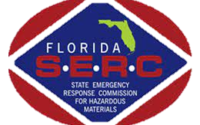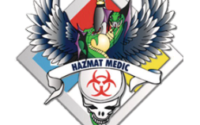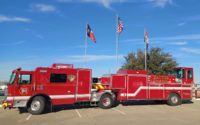HazMat Engines
Tony Perrone
Entering the fire service demands a mastery of numerous disciplines. Whether you’re a fresh-faced probie emerging from training or a seasoned veteran counting down the years, the journey is fraught with evolving policies, procedures, tactics, and hazards. Yet, amid the discourse, one discipline often overlooked is the response to hazardous materials. With an increasing number of companies tasked with this critical duty, particularly engine companies, the landscape for firefighters today is both challenging and dynamic. As industries evolve and new substances emerge, the complexity of hazardous materials incidents escalates, demanding constant adaptation and vigilance from those on the front lines. Understanding the nuances of hazardous materials, from identification to mitigation, is no longer a niche skill but a vital component of modern firefighting. In this ever-shifting environment, staying abreast of the latest protocols and technologies is not just advisable but imperative for ensuring the safety of both responders and the communities they serve. So, what strategies are emerging to confront this multifaceted hazard, and how are firefighters being equipped to navigate this increasingly intricate terrain? These questions underscore the pressing need for ongoing dialogue and innovation within the fire service to effectively address the challenges posed by hazardous materials incidents in the 21st century.
Across the nation, engine companies stand as pillars of emergency response, entrusted with an ever-expanding array of duties—from attending to medical emergencies and navigating through car accidents to executing intricate rescue missions and, more recently, addressing hazardous materials incidents. The evolving landscape of emergency services has placed a growing burden on our members, who find themselves navigating a labyrinth of diverse disciplines. Step into any firehouse from coast to coast, and you’re likely to overhear discussions centered on recent “jobs” or tactics aimed at optimizing firefighting effectiveness—a testament to the dedication and proficiency of our firefighting personnel.
Undoubtedly, mastering the traditional firefighting skills was a foundational expectation for those who committed to serving in engine companies. Yet, the introduction of hazardous materials response injects a new layer of complexity into an already demanding profession. Unlike skills learned through informal channels or passed down over kitchen tables, proficiency in hazardous materials handling demands a structured and exhaustive training regimen. Achieving certification in this domain requires not just dedication but also hundreds of hours of rigorous instruction.
However, certification is just the beginning. The dynamic nature of hazardous materials incidents necessitates ongoing education and skill refinement. Maintaining readiness in this specialized field demands a level of dedication comparable to, if not exceeding, that required for firefighting proficiency. It’s a relentless pursuit of excellence, where constant training and equipment familiarity are essential for effective response.
Traditional firefighting training offers numerous advantages in emergency response. It enables effective planning and the ability to anticipate potential actions and hazards during the response, allowing proactive measures to be implemented beforehand and better preparedness to address them. However, hazmat response operates differently. While it’s possible to preplan a response, the hazards associated with various chemicals can significantly challenge response tactics, potentially leaving responders inadequately prepared for unexpected changes. Unlike traditional firefighting tactics aimed at eliminating or removing individuals from hazards, hazmat response focuses on mitigating potential or imminent dangers.

In essence, as engine companies expand their repertoire of services to meet the evolving needs of their communities, the dedication and adaptability of their members stand as the cornerstone of their effectiveness. Whether tackling a structure fire, stabilizing a hazardous materials spill, or providing life-saving medical aid, our engine company members embody the spirit of service and readiness that defines the firefighting profession.
This following delves into the crucial aspect of maintaining motivation among firefighters to excel in hazmat response, emphasizing the pivotal role management plays in fostering this commitment. It stresses that management must fully endorse and support this new discipline, both financially and through adequate training opportunities. The author highlights the considerable expense associated with hazmat equipment, which often exceeds the costs of traditional firefighting gear. Despite the financial challenges, managers are tasked with ensuring that hazmat response capabilities are not neglected, as doing so would compromise both the safety of firefighters and the effectiveness of emergency response efforts. Additionally, the following underscores the importance of ongoing training support from management to ensure firefighters are prepared to handle hazardous materials incidents effectively.
Let us discuss how we can keep the members motivated to take on this new task and be proficient at it. This writer believes that the buy-in must start with management. Hazmat response is not cheap. The cost of equipment far out paces the cost of most firefighting equipment, sans emergency response vehicles. Managers have the daunting task of balancing finances and keeping all equipment up to standard, while being certain to include hazmat considerations.
As the above states, motivating members by management can be a daunting task. It’s important to remember that motivating members is a team effort. Members signed up to fight fires and perform rescues. Most weren’t aware that this newfound discipline would be slid across their plate. Nevertheless, most members have in fact taken the task of hazardous materials response very seriously. Company pride and knowing that the citizens are relying on firefighters to “make everything better” ultimately drives the response of many. In the fire service we all know that there is nothing better than knowing that your company was tasked with a particular job and that you and your members completed the work efficiently. With that, most companies would then build off that experience and share the knowledge learned. Knowing that you and your company are in the forefront of sharing new vital information can and has given members the drive to continue to educate themselves, train, and stay motivated.

This article discusses the increasing responsibility of engine companies in responding to hazardous materials incidents withing the fire service. It highlights the challenges faced by firefighters, from new probies to seasoned veterans, in staying proficient in various disciplines amidst evolving policies, procedures, tactics, and hazards. Engine companies are now often tasked with not only firefighting but also medical responses, car accidents, rescue work, and hazardous materials response.
The article emphasizes the complexity of hazmat response and the significant training required to handle and mitigate hazardous materials effectively. It stresses the importance of management buy-in to support firefighters in acquiring the necessary training and equipment for hazmat response. This includes providing financial support for equipment and training, as well as balancing resources to maintain proficiency in all disciplines. The article underscores the need for ongoing support from management to ensure firefighters can effectively respond to hazardous materials incidents.



